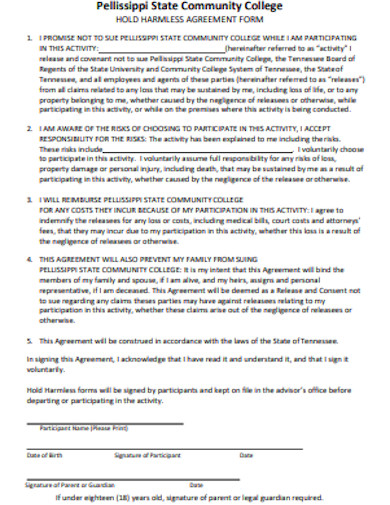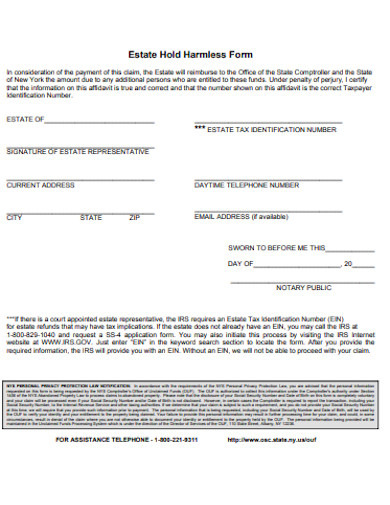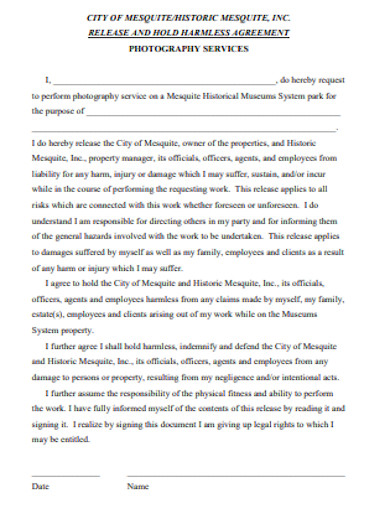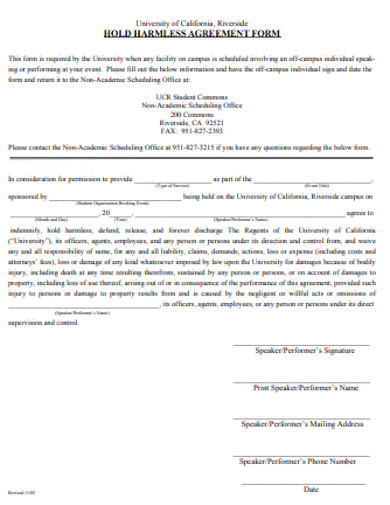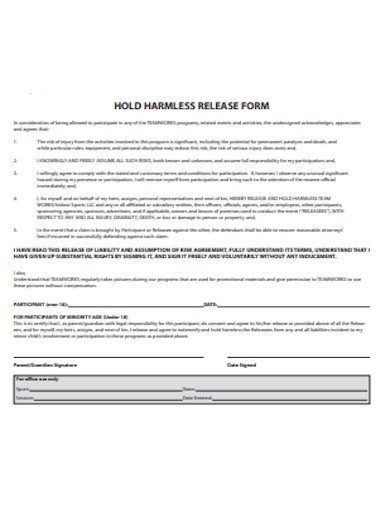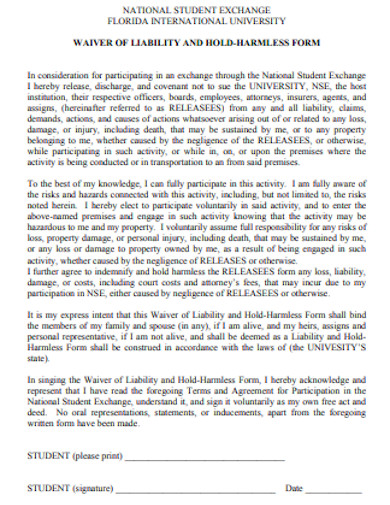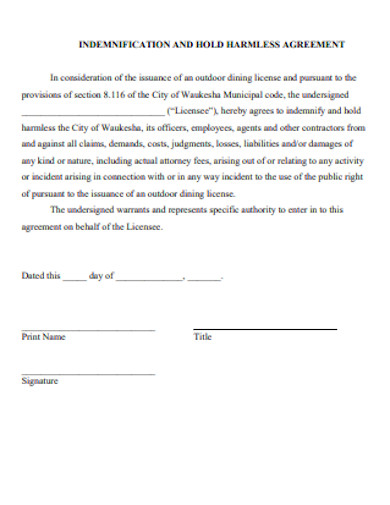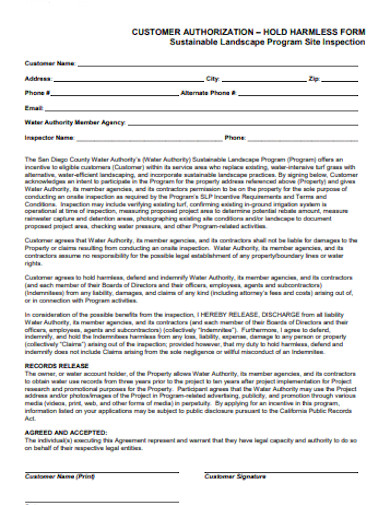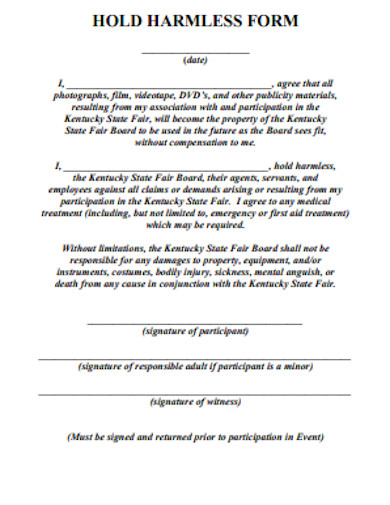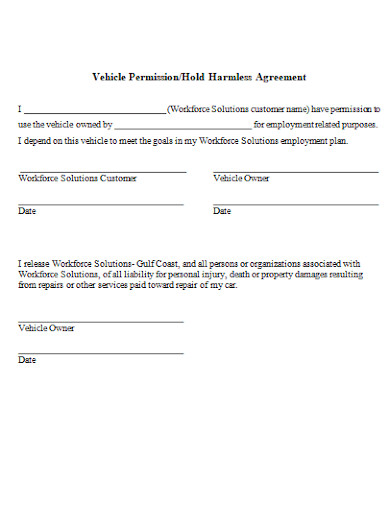10+ Hold Harmless Form Examples to Download
Both service providers and consumers wouldn’t want to miss the chance to make their every business transaction smooth and convenient. This is very much applicable in situations when you have to make independent contractor or subcontractor agreements or legal arrangements with your customers regarding liability, indemnity, and other things as such. For long-established businesses and knowledgeable consumers, it is obvious that creating agreements for the said purposes over and over again is hassling. However, whether you tackle repossession of leased equipment or property or protection on a medical matter, a hold harmlessagreement must be made in compliance with basic agreement standards. To provide a solution to this fuss, forms have been made. And when it concerns indemnification, our Hold Harmless Form Examples is a great reference for you.
10+ Best Hold Harmless Form Examples
1. Hold Harmless Agreement Form
2. Estate Hold Harmless Form
3. Release and Hold Harmless Form
4. Hold Harmless Agreement Form Example
5. Sample Hold Harmless Form
6. Hold Harmless Release Form Example
7. Waiver of Liability and Hold Harmless Form
8. Indemnification and Hold Harmless Form
9. Hold Harmless Form Example
10. Sample Hold Harmless Form Example
11. Hold Harmless Agreement Form Sample
What Is a Hold Harmless Form?
A hold harmless form is a fillable and ready-made legal document that outlines a hold harmless agreement specifications for both promisor and promisee. According to TemplateLab, it is necessary for organizations and individuals to create such an agreement preliminarily. Why? The same website reasoned out that doing so helps protect the individuals and organizations from lawsuits regarding liabilities, as well as possible bankruptcy due to reimbursements. And since it is a document that is discussed, understood, and agreed upon by participants, the set details may not always be favorable to the promisor. In other words, it is made to be just.
6 Instances When Hold Harmless Form Is Useful
There are many situations when a hold harmless form becomes necessarily useful. Based on Rocket Lawyer, the following are the common cases that support the aforementioned fact:
1. When you are participating in an unsafe activity, and you assent not to blame another party for self-inflicted damages or losses.
2. When you hold a risky physical event, like sports, and you want to be free of accountability from inevitable injuries.
3. When an unforeseen and unwanted incident takes place in your property during your supported ongoing event, and the injured parties do not blame you for what happened.
4. When you employ a contractor to conduct a risky service operation, and you want to be held secure in case injuries will happen because of the said operation.
5. When you organize an event, and you do not want to be accounted for in any damage, loss, and injury.
6. When your property is leased, and you do not want to be responsible for any injuries caused by the lessees’ negligence.
How to Create a Hold Harmless Form
As mentioned above, hold harmless forms must be prepared before any relative transaction happens. Therefore, there is a need for you to conduct thorough research to ensure that your forms are complete with all the necessary details that must be taken into account. But, we encourage you not to break a sweat because we have listed everything that you are going to need below.
Step 1: Present Parties’ Information and Form Purpose
There are two participants in a hold harmless form. They include the promisor and promisee. It is important to specify their corresponding accurate basic information, first and foremost, for future legal references. After presenting the participants’ basic details, briefly describe the form’s purpose and state under what circumstance it is made for.
Step 2: Propound Areas of Consideration
Expenses, indemnity, notices, claims, and the prospective third party are among the important areas that must be put into consideration in a hold harmless form. These sections must be clearly defined and filled with appropriate points.
Step 3: Expressing Indemnification
In this part, you express the main purpose of your hold harmless form elaborately. It is also in this part where the promisor pledges to take accountability for civil liabilities that he or she thinks are suitable in his or her position.
Step 4: Cite Limitations
The previous section only focuses on setting the lay circumstances. It is in this section where the promisor specifies the instances that he or she should not be taken accountable for. Most of the time, the specifics on this section are those that surpass state regulations.
Step 5: Prepare Notice of Claim
Just in case an injury, a damage, and loss occurs, your hold harmless form must be ready with a notice of claim. This is so the participants can immediately present any dispute that disregards an item in the list of indemnification to the legal court.
Step 6: Hammer Out
To ensure that both of the participants understood and agreed on the discussed agreement, there should be a portion on your hold harmless form where they can imprint their signatures. You may need to conduct the imprinting of signatures with a notary public. After sealing the deal, do not forget to create copies for safekeeping.
What are the different types of hold harmless forms?
There are three types of hold harmless forms. They include the following:
1. Limited Form – the promisee will be held accountable for the damages caused by their negligence but only on the part where they are responsible for.
2. Broad Form – the promisee will be deemed responsible for all damages, losses, and injuries.
3. Intermediate Form – the damages, losses, and injuries are considered the responsibilities of both parties. However, only the party who acted behind the incident will be held accountable.
What are the other names for hold harmless forms?
– Hold Harmless
– Hold Harmless Letter
– Hold Harmless Agreement
– Hold Harmless Clause
– Waiver of Liability
– Hold Harmless Release
– Release of Liability
What is an indemnitor and indemnitee?
An indemnitor refers to an individual or organization that acts on the responsibilities to redeem the damages or losses sustained by the indemnitee. Hence, indemnitee refers to an individual or organization that is subject to be compensated for incurring any harm or loss, as well as to be protected from any liabilities.
It has been strongly established that the main purpose of a hold harmless form is to protect either of its participants from taking the accountability of damages, losses, and injuries caused by one of the parties. Needless to say, the document is essential for individuals’ and organizations’ business undertakings.



